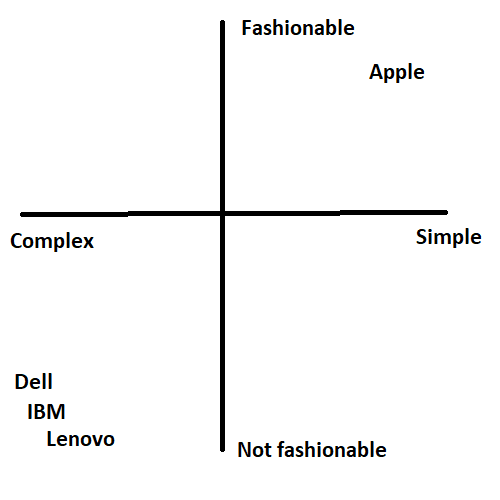Positioning - What does it mean and why should it be the foundation of your marketing?


Positioning typically refers to how your company's product or service stands out from the competition.
As stated in Wikipedia: “Positioning refers to the place that a brand occupies in the minds of the customers and how it is distinguished from the products of the competitors.”
While this blog will talk about why positioning should be the foundation of your marketing, positioning is not just about marketing. Positioning should be the basis for marketing, but it also affects everything else you do also.
Why position, if our product is just the best?
Without positioning, the question is just about which company produces the best product or service. Who produces the best car, who produces it most cost-effectively. Perhaps the best example of this is General Motors' “May the best car win” campaign.
Without taking a stand on how good or bad that GM's campaign was, it is obvious that this kind of a campaign will lead to price competition. Different companies start comparing each other's services, picking the best from them, and striving to produce them more efficiently. Until the margins are drived down and in practice only the operator with the largest scale can survive.
In the field of E-commerce, this trend is already visible when basic retail E-commerce stores that do not specialize in a particular area are losing to Amazon. If I were to look at the crystal ball at this point, it is obvious that all medium and small retailers will disappear, leaving only clearly positioned individual brands that sell direct to consumers, and large retailers such as Amazon, which have leverage from large volumes. Competing against them as a small business is almost impossible.
If you disagree with my thoughts on where the world is going. Think for a moment about a situation in which you want to buy a Playstation 4. You have 2 options as retailers. One huge retailer who sells the PS4 for 200$, with 1 day delivery. Smaller retailer who sells it for 240$, with 5 day delivery. Which one would you choose?
How does positioning change the competitive landscape?
Positioning focuses on the ability to satisfy the wants and needs of a particular segment as well as possible.
Apple's Macbook Pro may not be the best notebook on paper. However, it is the best computer for that particular target audience, to satisfy the particular wants and needs of that audience. Apple does not even try to compete with the same metrics that most computer manufacturers compete with, but competes with its "own rules".
Positioning therefore aims to be different. Not the best, but different. The goal is to give customers the option to purchase a different product or service. With correct positioning there is no alternative to buying a similar service for a little cheaper price from different business.
Thus positioning changes the nature of competition from imitation to innovation. Harvard Business Reviews article ”Stop Competing to Be the Best”, summarizes this difference, which you create via positioning. Referencing Michael Porter’s views on corporate strategy.
How do I position my service or product?
Simple and effective way to think about positioning, is for example Seth Godin's way of thinking about it. You can learn more about it from ”This is marketing” or by taking one of his online courses. But the basic idea is to create 2 axises that will create four quadrants.
Below is a simple example of a four quadrants. The quadrants can be thought of as representing most of the computer business. Most of the competition is for computers speed and price. Everybody strives to be as quick and as cheap as possible.

If you were to start a computer manufacturing company now, it would be quite difficult for you to beat the competition with speed and price. For this reason, it is a good idea to reinvent the four quadrants for yourself and try to compete on factors other than speed and price.
An example of this could be Apple. Instead of speed and price, Apple’s quadrants could be drawn with fashionability and simplicity. Everyone else is fighting to be quick and cheap. Apple is playing in its own field. Apple is not for those who want a fast computer for cheap price. Apple is for those who want simple and fashionable computer.

So what matters to Positioning is finding the differentiating factors that you want to highlight and really differentiate your service. This will give potential customers a chance to remember your brand. You are not like everyone else and don't compete in the same terms as everyone else. You are different and you do not even compete for the same customers. You satisfy different desires.
Still, if you compare parts found on Apple computers to a Windows PC of the same Price Range. Almost invariably, that Windows computer wins on paper in quality of parts. However, Apple is more fashionable and simpler to use.
Seth Godin has summed this up almost perfectly:
”People like us do things like this.”
People like us do things things like this. If you want something else, this is not for you, buy another product that meets your needs. Do not try to be everything for everyone but be what certain people want.
Positioning as a base for marketing
If at this stage it is not yet clear how positioning will serve as the basis for marketing, let's clarify it little more. Positioning is built around the company's core message and the story that customers are told and identified with.
It is essential that positioning does not refer to demographic targeting. But about targeting psychographically. People like us act and think in this way. It doesn't matter in principle whether they are men or women, 20s or 70s, CEOs or marketing managers, and so on.
Of course, often through these demographic factors one can find psychographically the same group, but when considering positioning, one should not get stuck in demographics. In addition, of course, advertising platforms like Facebook allow targeting so that people who are interested in a particular ad or are more likely to buy will see it, that is, in a certain way, psychographic targeting is possible.
To summarize positioning
Positioning is quite essential for sales and marketing, but it is good to remember that even if the company is not consciously positioned, the company has some position in the minds of customers, if you are remembered.
Often successful companies position their services or products almost naturally, without thinking of any great theories or the like. Often, however, using certain tools helps, especially when the results that are sought are not completely achieved.
